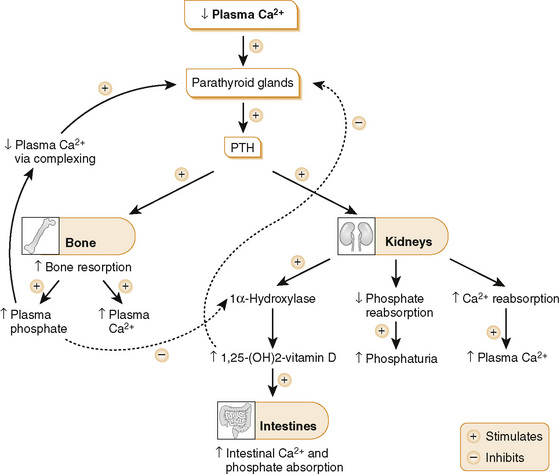Chapter 25 Drugs Used in the Treatment of Bone and Calcium Disorders
• Parathyroid hormone (PTH) and vitamin D play a role in the regulation of calcium and phosphorus (Fig. 25-1; and Table 25-1); See Rapid Review Pathology

25-1 Parathyroid hormone (PTH) overview.
(From Brown TA. Rapid Review Physiology. Philadelphia, Mosby, 2007, Figure 3-20.)
TABLE 25-1 Actions of Parathyroid Hormone and Vitamin D on Intestine, Kidney, and Bone
| Area of Action | Parathyroid Hormone | Vitamin D |
|---|---|---|
| Intestine | ↑ Calcium and phosphate absorption by ↑synthesis of 1, 25-(OH)2D | ↑ Calcium and phosphate absorption |
| Kidney | Calcium and phosphate excretion may be ↓ by 25-(OH)D and 1,25-(OH)2D* | |
| Bone | ||
| Net effect on serum levels |
* Direct effect; Vitamin D often ↑ urine calcium due to ↑ calcium absorption from the intestine and resulting ↓ PTH.
(2) Inhibits 24 hydroxylase in proximal tubule, which normally converts 25-hydroxycholecalciferol synthesized in the liver to inactive 24,25-(OH)2D.
• A compensatory mechanism when chronic hypocalcemia (malabsorption, vitamin D deficiency) is present
a. Dehydrocholesterol in the skin is photoconverted by sunlight to ergocalciferol (vitamin D2) and cholecalciferol (vitamin D3) in the skin.
b. Reabsorbed vitamin D precursors are first metabolized in the liver by the cytochrome P-450 system to 25-hydroxyvitamin D or 25-(OH)D (calcidiol), which is converted to metabolically active 1, 25-(OH)2D3 (calcitriol)by 1-α-hydroxylase in the proximal renal tubule cells (Fig. 25-2; see also Table 25-1).



